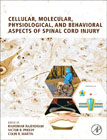
Cellular, Molecular, Physiological, and Behavioral Aspects of Spinal Cord Injury
Rajendram, Rajkumar
Preedy, Victor R.
Martin, Colin R.
Spinal injury affects about 10 million people annually worldwide, impacting on the family unit and causing lifelong disabilities, with varied symptoms including paresthesia, spasticity, loss of motor control, and often severe pain. Cellular, Molecular, Physiological, and Behavioral Aspects of Spinal Cord Injury will enhance readers' understanding of the biological and psychological effects of spinal cord injury. Featuring chapters on gene expression, metabolic effects, and behavior, this volume discusses in detail the impact of spinal cord injury to better understand the underlying pathways and processes. The book has applicability for neuroscientists, neurologists, clinicians, and anyone working to better understand these injuries. Summarizes the neuroscience of spinal cord injury, including cellular and molecular biology Contains chapter abstracts, key facts, dictionary, and summary points to aid in understanding Features chapters on signaling and hormonal events Includes plasticity and gene expression Examines health and stress behaviors after spinal cord injury INDICE: Section 1. Setting the Scene: The Spectrum of Spinal Injury1. Causes of spinal injury: motor vehicle accidents and beyond2. Global aspects of traumatic spinal injury3. Economics of traumatic spinal injury4. Spinal cord injury and the risk of dyingSection 2. Cellular and Molecular Aspects5. Spectrum of syndromes in spinal injury Central cord syndrome and beyond6. Neuroinflammation in spinal cord injury7. Spinal cord injury and cellular excitotoxicity8. Cytokines and spinal cord injury9. Cells and spinal cord injury: a focus on glial cells10. Regenerative response of after spinal injury: propriospinal neurons and beyond11. Astrocytes in spinal cord injury12. Linking spinal cord injury and remodeling of the enteric neuromuscular compartment13. Leukocyte gene expression and spinal cord injury14. Angiotensin-(1-7) receptor Mas and spinal cord injury15. Coenzyme Q10, Bax/Bcl2 and Spinal cord injury16. Signalling pathways in spinal cord injury: a focus on ERK and AKT17. Wnt signaling in spinal cord injury18. Gene expression and spinal cord injury: a focus on the motor cortex19. Glucose metabolism and gene expression in spinal cord injury20. Receptors in spinal cord injury: a focus on glutamatergic and glycinergic receptors21. Ion channel and receptors: gene expression and in spinal cord injurySection 3. Physiological and Metabolic Effects22. Hormonal events and spinal cord injury: a focus on vasopressin and natriuretic peptide23. Linking sensorimotor plasticity, the motor cortex and spinal cord injury24. Spinal cord injury-induced spasticity25. Effects of spinal cord injury: Cerebral perfusion and autonomic cerebrovascular control26. Skeletal muscle atrophy in spinal cord injury27. Bone mass and spinal cord injury: risk of fractureSection 4. Behavioural and Psychological Effects28. PTSD and spinal injury29. Health behaviors after spinal cord injury: alcohol use and beyond30. Oxidative stress in spinal cord injury31. Features of endoplasmic reticulum stress: applications to spinal cord injury32. Health behaviors, people with spinal cord injury33. Quality of life in cervical traumatic spinal cord injury34. Empathy in spinal cord injury35. Daily living measures in spinal cord injury
- ISBN: 978-0-12-822427-4
- Editorial: Academic Press
- Encuadernacion: Cartoné
- Páginas: 580
- Fecha Publicación: 24/06/2022
- Nº Volúmenes: 1
- Idioma: Inglés
